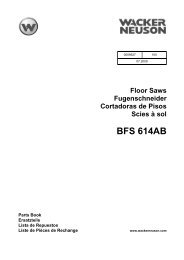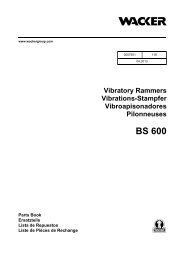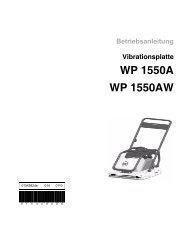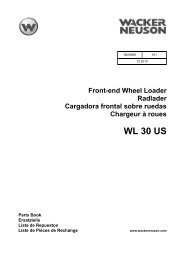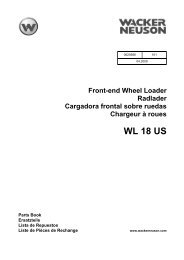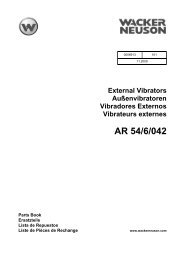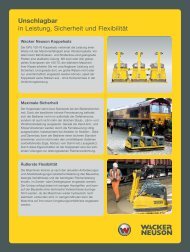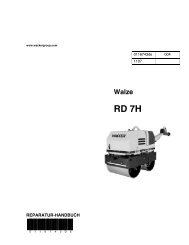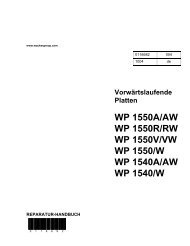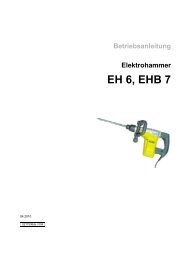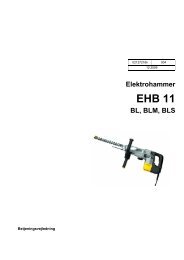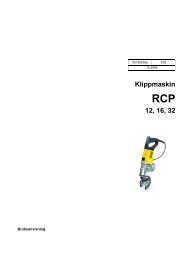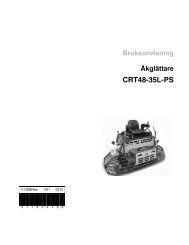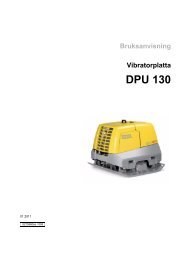You also want an ePaper? Increase the reach of your titles
YUMPU automatically turns print PDFs into web optimized ePapers that Google loves.
4 PG SERIES PUMPS PT / PG / PD REPAIR<br />
4.13 Inspecting Pump<br />
Before disassembling pump, check for conditions both<br />
outside and inside the pump which could affect performance.<br />
Inspecting Outside Pump:<br />
CHECK THAT THE PUMP IS OPERATING WITHIN<br />
SPECIFICATIONS.<br />
Remember that as suction lift and discharge head<br />
increases, pump output is reduced.<br />
CHECK TYPE OF FLUID BEING PUMPED.<br />
Pump will perform poorly if used to pump heavy<br />
sludges or mud.<br />
CHECK SUCTION HOSE FOR LEAKS OR DAM-<br />
AGE.<br />
A puncture or tear above the water line will make the<br />
pump difficult or impossible to prime.<br />
CHECK THAT SUCTION HOSE IS CORRECT TYPE.<br />
Suction hose must have strong rigid walls. Thinwalled<br />
collapsible hoses like those used on the discharge<br />
side cannot be used.<br />
CHECK THAT STRAINER HOSE LINES ARE NOT<br />
BLOCKED OR RESTRICTED.<br />
Remove any dirt, debris or vegetation which might<br />
interfere with pump flow. If possible, flush hose lines<br />
with clear water at the end of each operation and<br />
suspend strainer in water, rather than rest on sandy or<br />
muddy bottom. Check that discharge hose is not<br />
kinked.<br />
CHECK THAT ALL FITTINGS AND HOSE CLAMPS<br />
ON SUCTION LINE ARE TIGHT AND SEALING<br />
PROPERLY.<br />
Fittings and clamps may loosen during operation.<br />
Add additional clamps where necessary to ensure<br />
good seal.<br />
CHECK THAT PUMP CASE WAS FILLED WITH<br />
WATER AND PRIME PLUG SEALED TIGHTLY,<br />
BEFORE START-UP.<br />
4-10<br />
Inspecting Inside Pump:<br />
CHECK FOR DEBRIS AND DIRT INSIDE PUMP<br />
CASING.<br />
If allowed to accumulate, it may restrict flow through<br />
the pump or impede the movement of the impeller.<br />
CHECK ENGINE OPERATING SPEED.<br />
3600 ±100 RPM<br />
As engine operating RPM falls, pump capacity and<br />
discharge head are reduced.<br />
CHECK FLAPPER VALVE AND INLET PORT FOR<br />
LEAKS OR DAMAGE.<br />
If flapper valve is worn or distorted it may not seal<br />
tightly. Inspect threads on inlet port nipple for deep<br />
scratches which could allow air leaks.<br />
CHECK CLEARANCE BETWEEN IMPELLER AND<br />
VOLUTE INSERT.<br />
Additional shims are required to maintain clearance<br />
as impeller wears.<br />
CHECK PUMP HOUSING O-RING AND REAR<br />
PUMP FLANGE.<br />
Replace O-Ring if torn or crushed. Make sure cover<br />
is tightened evenly. Check that rear plate is not<br />
warped.<br />
CHECK FOR WATER LEAK BETWEEN PUMP<br />
HOUSING AND ENGINE. INSPECT MECHANICAL<br />
SEAL LUBRICANT AND ENGINE OIL.<br />
The presence of water indicates a loose impeller bolt<br />
or damage to mechanical seal.<br />
CHECK FOR OIL LEAK BETWEEN PUMP HOUS-<br />
ING AND ENGINE.<br />
An oil leak indicates a failed shaft seal.<br />
CHECK PUMP SUCTION WITH VACUUM GAUGE.<br />
If gauge reading is above 16 in. Hg (55 KPa), problem<br />
is probably outside the pump, in hose line or fitting.



